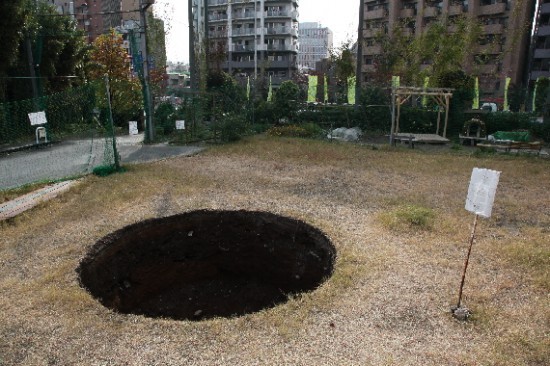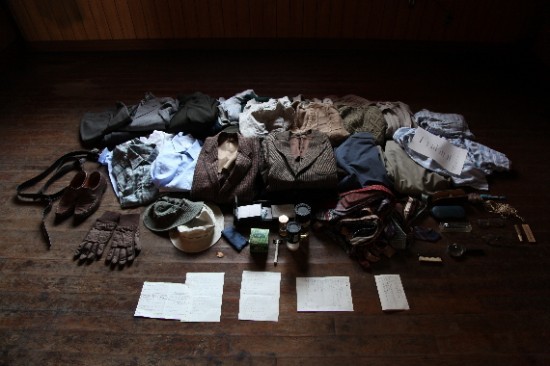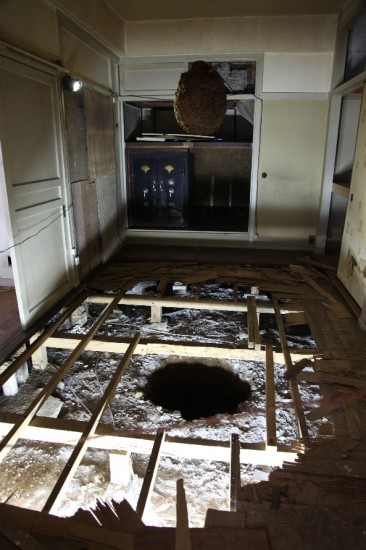A deep, black hole inside of ‘me’ (Part I)
 All images: Installation views of Norimizu Ameya’s The shape of me (2010) at Festival/Tokyo 10. All images courtesy Festival/Tokyo 10. © Yohta Kataoka.
All images: Installation views of Norimizu Ameya’s The shape of me (2010) at Festival/Tokyo 10. All images courtesy Festival/Tokyo 10. © Yohta Kataoka.Norimizu Ameya’s The shape of me was an official artwork at last year’s Festival/Tokyo 10 performing arts festival. It had neither script nor actors and wasn’t performed on a stage, but that doesn’t mean that it wasn’t theatre. In fact, the flyers promoting shape of me clearly stated, “Concept/Direction: Norimizu Ameya.” In this sense, as a start, the work should probably be thought of based on its distance from and position in relation to traditional theatre and the context in which it is viewed.
What makes me say this? With viewers reliant only on a simple map handed to them at each location, everyone had to begin by making their way from the first station at an old school grounds near the reception area, where a deep hole had been dug in the ground, to three properties located in an area stretching from the start point to the vicinity of Sugamo rail station (stations two, three and four respectively). Were one to interpret shape of me in an art context as an “installation utilizing abandoned houses,” far from being “beyond theatre,” it would actually fall within a pattern of sorts that has repeatedly appeared in art circles since the 1990s. Indeed, examples of something similar could be seen at the Setouchi International Art Festival held just prior to Festival/Tokyo in July-October 2010. In particular, to the extent that they relied on an inseparable combination of abandoned possessions and remaining traces of the former residents and art contributed by the artists, the installations by the collaborative duo Claire Healy & Sean Cordeiro and by Sue Hedley using abandoned houses in the village of Kou on Teshima and the installation by Yoshio Kitayama using a two-story house on Ogijima can be seen as bearing an extremely close resemblance to shape of me. Of course, each should be regarded as something unique, and in the latter case of Ameya the major difference is the discovery of a number of abandoned buildings in the very heart of the city. Nevertheless, looking at it as “art,” if we ignore the exhibition format of shape of me, it is difficult to see anything innovative about the work that demands special mention.
But what if we look at it as “theatre”? In other words, not as “an installation utilizing abandoned houses,” but as something in which the director Norimizu Ameya used as his stage abandoned houses, employed as actors “those (including the dead) who no longer live there,” and directed things in such a way that their presence was somehow restored despite their condition of absence (and with no one acting). In fact, rather than a fetishistic feeling towards the “things” inside these houses, what I felt strongly at each of the locations was a vivid presence – the breathing even – of the people “no longer living there” that floated to the surface via these “things” (in some cases this came within a hairbreadth of communication with the dead). At these moments, in the sense that it “transforms space and moves people” even without the presence of a stage, actors or script, shape of me seemed capable of dramatically reforming and liberating the traditional concept of theatre.
On the other hand, there will of course be those who see no need to be restricted to a particular genre, whether art or theatre, and who are happy to experience the work as it is. However, as long as something is under the umbrella of modern forms of “expression,” experiencing it “as it is” is nothing more than an illusion. People may assert this, but art appreciation even at the individual level rarely escapes classification according to type. Even granting, for arguments sake, that someone does undergo an acute experience while viewing shape of me, in respect to this “acuteness” it is in fact difficult to escape similar instances, and often this is what is mistaken for feelings of empathy.
Having analyzed the work in the voice of critic, I would now like to offer some comments from a completely different perspective. The first thing I would like to mention is that in the sense that it comprised text, sounds and signs of loss, shape of me has a strong connection to the exhibition “Vanishing Point” (2005, P-House, Tokyo), for which Ameya shut himself in a box in the gallery for 24 days. In place of the sound supplied by Yoshihide Otomo on that occasion, the new work had sound by Sachiko M and Ami Yoshida, while the text that I supplied for the 2005 show was replaced with text borrowed from Christian scripture.

As well, the omission of characters in the Japanese title of the “Vanishing Point” exhibition and the non-appearance of the artist were transformed in this latest exhibition into physical “holes” dug at each “station.” Another similarity is that in the 2005 exhibition, rather than constituting the “artwork,” the items brought into the gallery served as media that drew attention to the “presence” of people who were “not here now.” There is a clear connection between this and the arrangement of the remains and mementos of Ameya’s late father that was presented in the second-floor room of the “after-hours clinic” that corresponded to “station four” in shape of me. Ameya’s “disappearance” achieved by shutting himself in a box in “Vanishing Point” could be thought of as an act not designed to “fill” with something else the sense of loss he felt upon his father’s death, but rather an act in which Ameya himself “became” that “loss” by repeating the disappearance – an act that is impossible while one is still alive – and precisely for this reason a kind of “theatre of loss.” In shape of me, this “theatre of loss” was repeated, this time by recalling those who were no longer present to serve as actors while remaining absent.
Of course, it’s not as if there are no differences. Of these differences, perhaps the greatest is the two confessionals set up inside the second station, “Half a Church.” There were relatively few visitors when I was there, and following the instructions, I entered one of the confessionals alone and slowly studied the confessions of sins that had been left by others on the wall and then, on the ceiling of the next room, wrote slowly and in large letters, “Not guilty.” I did this not because I felt innocent compared to these other people, but because in the final analysis I thought the kinds of things people had written (even though in some cases these were confessions of crimes or moral transgressions), didn’t really amount to “sins.” To be frank, they seemed to me like nothing more than acts of ordinary living.

But even more intriguing is why for Ameya his father’s death continues to be such a pressing issue. One could say that this is only natural in the case of the passing of an immediate family member, but there is something opaque here. Ultimately, what interested me the most about shape of me came down to this opacity rather than the shell in the form of the abandoned houses, the confessionals, and so on. Throughout this latest work Ameya talked about nothing but himself from start to finish. Which is why for a moment the empathy of the confessional and the sharing of the space seemed to trigger a strange empathy among those who visited these places, but in fact the only real stratagem Ameya had at his disposal was for everything to be swallowed up in the unpleasantness of the first station, “The Opening Hole.” To put it another way, precisely because “internal empathy is difficult,” in order for this gap not to be filled by something (confessions, for example), but rather for it to visually represent the difficult-to-fill gaps that exist within all of us, the only option available to Ameya was “to physically dig a hole.”
That being the case, it would be even more natural if after the exhibition concluded, a one-day-only “vestiges exhibition” had been mounted in which the various locations were restored to their original conditions, and in which despite the holes being filled with the earth that was originally in them, the bodily sensation of “holes having once been there” remained without an effort being made to fill them. In other words, holes weren’t dug as such. Rather, these particular holes were dug to open our eyes to the “holes” that existed inside us from the beginning. As well, it is precisely because they can’t be shared with everyone that they are “holes.” However, the fact is this was also pointed out clearly from the very beginning in Ameya’s own words. By this I mean the very title, “The shape of me,” which excludes others.
Accordingly, even if the holes were filled in with dirt after the exhibition, the loss would have actually been deeper on account of them losing their shape. And so rather than sharing our sins, all we can do is – as Ameya says – take these holes that the other in the form of Ameya has exposed inside of each of us and, instead of trying to fill them in, make full use of them as “tools” that belong to no one.
Norimizu Ameya‘s The shape of me was simultaneously presented at multiple locations in the Sugamo area of Tokyo from October 30 to November 28, 2010, as part of Festival/Tokyo 10.
